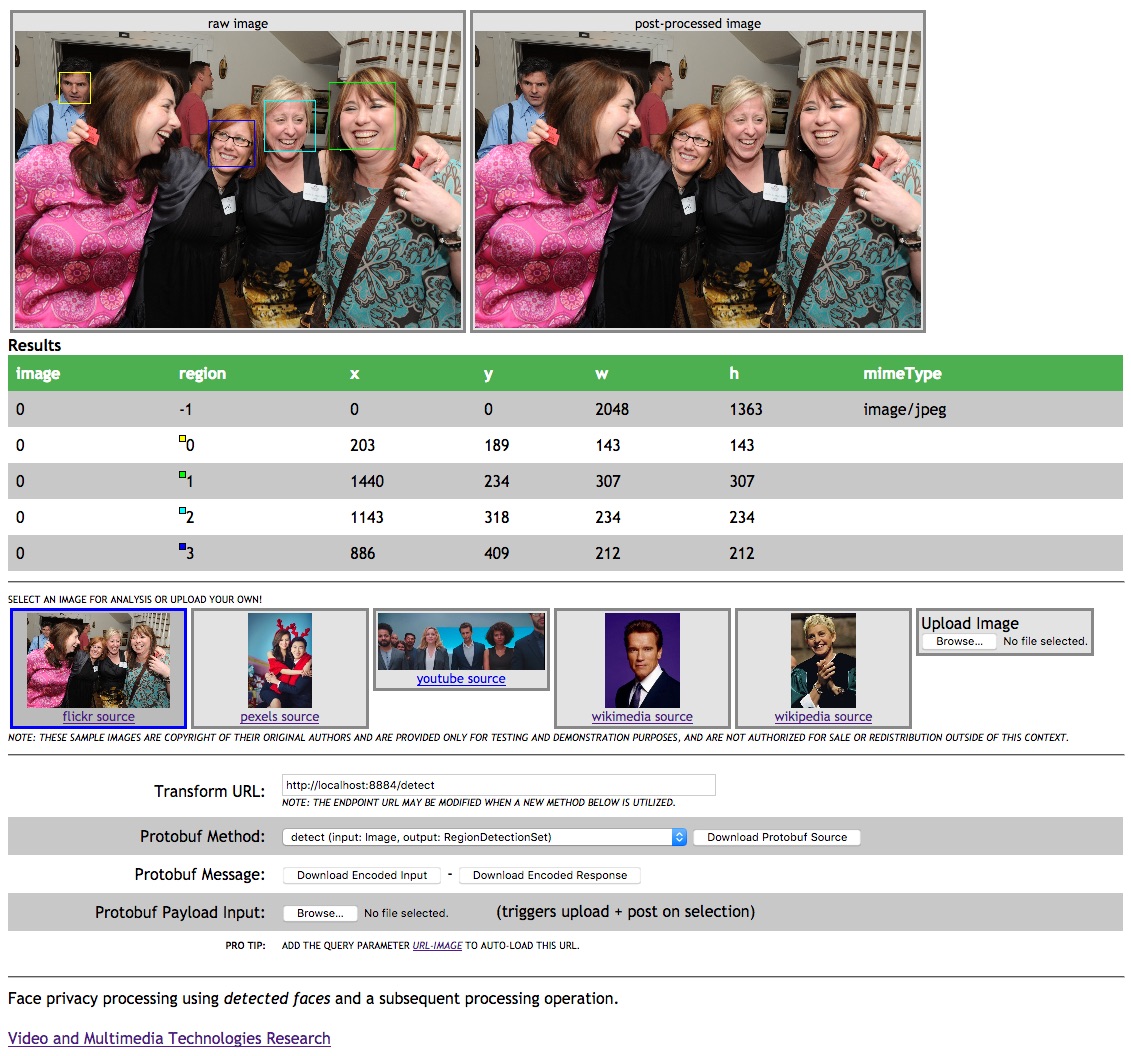Demonstrations: Tutorial for Face Privacy¶
Web Demo¶
This web page sample allows the user to submit an image to a face detection and a face pixelation service in serial progression.
- *Image Copyrights May Apply* - the included sample videos may
carry additional copyright restrictions and are not meant for public resale or consumption.
Browser Interaction¶
Most browsers should have no CORS or other cross-domain objections to
dropping the file face-privacy.html into the browser and accesing a
locally hosted server API, as configured in Deployment: Wrapping and Executing Face Privacy Models.
Open-source hosted run¶
Utilizing the generous htmlpreview function
available on GitHub, you
can also experiment with the respository-based web resource. This
resource will proxy the repository web_demo directory into a live
resource.
Navigate to the default webhost page and confirm that the resource load properly. The image at the bottom of this guide is a good reference for correct page loading and display.
After confirming correct page load, simply replace the value in the
Transform URL field to point at your deployed instance. For example,
if you’ve created a dumped model locally, it might be a localhost port.
Local webserver run¶
If you want to run the test locally, you can use a supplied python
webserver with the line below while working in the web_demo
directory (assuming you’re running python3).
python simple-cors-http-server-python3.py 5000
Afterwards, just point your browser at
http://localhost:5000/face-privacy.html.
Usage of protobuf binaries for testing¶
Binary (protobuf encoded) data can be downloaded from the web page or directly with curl. Two demonstration binaries have been included in the source repository for testing.
protobuf.Image.bin- a protobuf-encoded image of Ellen DeGeneresprotobuf.RegionDetectionSet.bin- a protobuf-encoded region set from the reunion example
Within the webpage demo, simply select the correct protobuf method and then drag and
drop the binary file into the Protobuf Payload Input file uploader. It will be
immediately uploaded through javascript to your specified Transform Url.
Example face privacy demo (docker and protobuf)¶
To customize this demo, one should change either the included javascript or simply update the primary classification URL on the page itself during runtime. This demo utilizes the javascript protobuf library to encode parameters into proto binaries in the browser.
*NOTE* One version of the face model’s protobuf schema is
included with this web page, but it may change over time. If you receive
encoding errors or unexpected results, please verify that your target
model and this web page are using the same .proto file.
confirm that your target docker instance is configured and running
download this directory to your local machine
confirm the host port and classification service URL in the file
face-privacy.jsmodify the
protoDefaultsetting to be 1urlDefault: "http://localhost:8884/model/methods/detect",
view the page
face-privacy.htmlin a Crome or Firefox browseryou can switch between a few sample images or upload your own by clicking on the buttons below the main image window
Compatibility¶
If you want to run against the Boreas model runner you must set the URL to end with /model/methods/detect. The key is that in Boreas release the model runner api has changed. You can see the swagger for the model if you visit the source model’s swagger.
If you have a model that was onboarded using Athena release you do not need the /model/methods check. Use /detect instead. Another change that was made in Boreas model runner was that you must send the http headers before the default was protobuf. These headers will change automatically when use use /model/methods/detect as the URL path.
- Content-type: application/vnd.google.protobuf
- Accept: application/vnd.google.protobuf
Special decoding example¶
In protobuf mode, you can also download a binary, encoded version of
the last image that was sent to the remote service. When available, the
Download Encoded Message button will be enabled and a binary file will
be generated in the browser.
protoc --decode=HipTviKTkIkcmyuMCIAIDkeOOQQYyJne.Image model.pixelate.proto < protobuf.bin
NOTE The specific package name may have changed since the time of
writing, so be sure to check the contents of the current .proto
file.
Example face privacy demo (HTTP parameters)¶
To customize this demo, one should change either the included javascript or simply update the primary classification URL on the page itself during runtime.
confirm that your local instance is configured and running
download this directory to your local machine
confirm the host port and classification service URL in the file
face-privacy.jsmodify the
protoDefaultsetting to be 0urlDefault: "http://localhost:8884/transform",
view the page
face-privacy.htmlin a Crome or Firefox browseryou can switch between a few sample images or upload your own by clicking on the buttons below the main image window
Example Interface¶
An instance should first be built and downloaded and then launched
locally. Afterwards, the sample application found in the
web_demo directory uses a localhost service to classify and
visualize the results of image classification.
- Commercial example (youtube source)
- Reunion face sample flickr source)
- family face example (pexel source)
- DiCaprio celebrity face sample (wikimedia source)
- Schwarzenegger celebrity (wikimedia source)
- DeGeneres celebrity face sample (wikipedia source)

Reuse with object detectors¶
This framework can be used to demonstrate other detector and manipulation models
as well. If the detect model included in this repo is used, faces can be detected
and illustrated as shown below. The example below shows use of the
relevant endpoint and .proto file (also included in this sample).

